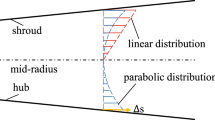Abstract
This contribution is dedicated to the modeling of the end-wall flows in a throughflow model for turbomachinery applications. The throughflow model is based on the Euler or Navier-Stokes equations solved by a Finite-Volume technique. Two approaches are presented for the end-wall modeling. The first one is based on an inviscid formulation with dedicated 3-D distributions of loss coefficient and deviation in the end-wall regions. The second approach is directly based on a viscous formulation with no-slip boundary condition along the annular end-walls and blade force modification in the region close to the end-walls. The throughflow results are compared to a series of 3-D Navier-Stokes calculations averaged in the circumferential direction. These 3-D calculations were performed on the three rotors of a low pressure axial compressor, for a series of tip clearance values.
Similar content being viewed by others
References
S. Baralon, L.-E. Erikson and U. Hall. Viscous Throughflow Modelling of Transonic Compressors Using a Time-Marching Finite-Volume Solver. Proceedings of the 13th International Symposium on Airbreathing Engines (ISABE), Chattanooga, 1997.
J.D. Denton and W.N. Dawes. Computational Fluid Dynamics for Turbomachinery Design. In Developments in Turbomachinery Design, John Denton editor, Professional Engineering Publishing, 1999.
R.P. Dring. Radial Transport and Momentum Exchange in an Axial Compressor. Transactions of the ASME Journal of Turbomachinery, 115: 477–486, 1993.
S.J. Gallimore. Viscous Throughflow Modelling of Axial Compressor Bladerows using a Tangential Blade Force Hypothesis. ASME Paper 97-GT-415, 1997.
W.M. Kšnig, D.K. Hennecke, and L. Fottner. Improved Blade Profile Loss and Deviation Angle Models for Advanced Transonic Compressor Blading: Part I — A Model for Subsonic Flow, Part II — A Model for Supersonic Flow. Transactions of the ASME Journal of Turbomachinery, 118: 73–80, 1996.
E.W. Pfitzinger and W. Reiss. A New Concept for Loss and Deviation Prediction in Throughflow Calculations of Axial Flow Compressors. Proceedings of the 2nd European Turbomachinery Conference, Antwerpen, 1997.
W.B. Roberts, G.K. Serovy and D.M. Sandercock. Modeling the 3-D Flow Effects on Deviation Angle for Axial Compressor Middle Stages. Journal ofEngineering for Gas Turbines and Power, 108, 1986.
W.B. Roberts, G.K. Serovy and D.M. Sandercock. Design Point Variation of 3-D Loss and Deviation for Axial Compressor Middle Stages. ASME Paper 88-GT-57, 1988.
J. Simon and O. Léonard. A Throughflow Analysis Tool Based on the Navier-Stokes Equations. Proceedings of the 6th European Turbomachinery Conference, Lille, 2005.
J.A. Storer and N.A. Cumpsty. Tip Leakage Flow in Axial Compressors. Transactions of the ASME Journal of Turbomachinery, 113: 252, 1991.
A. Sturmayr and C. Hirsch. Shock Representation by Euler Throughflow Models and Comparison with Pitch-Averaged Navier-Stokes Solutions. ISABE 99-7281, 1999.
Author information
Authors and Affiliations
Corresponding author
Rights and permissions
About this article
Cite this article
Simon, JF., Léonard, O. Modeling of 3-D losses and deviations in a throughflow analysis tool. J. of Therm. Sci. 16, 208–214 (2007). https://doi.org/10.1007/s11630-007-0208-x
Received:
Issue Date:
DOI: https://doi.org/10.1007/s11630-007-0208-x




